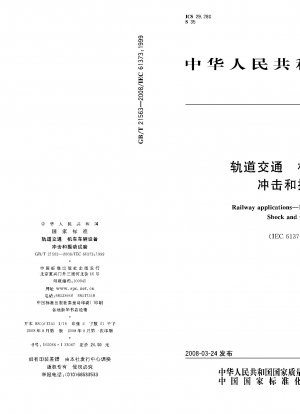GB/T 21563-2008
Railway application.Rolling stock equipment.Shock and vibration tests (English Version)
- Standard No.
- GB/T 21563-2008
- Language
- Chinese, Available in English version
- Release Date
- 2008
- Published By
- General Administration of Quality Supervision, Inspection and Quarantine of the People‘s Republic of China
- Status
- 2019-01
- Replace By
- GB/T 21563-2018
- Latest
- GB/T 21563-2018
- Replace
- TB/T 3058-2002
- Scope
- This standard specifies requirements for random vibration and shock testing of equipment intended to be installed on rolling stock. Due to the influence of the track operation environment, the equipment on the vehicle will be subjected to vibration and shock. In order to ensure the quality of the equipment, it should be tested for a period of time by simulating the environmental conditions of the equipment. A series of methods can be used to simulate the long-life test. These methods have their own advantages and disadvantages. The most commonly used methods are: a) Amplitude enhancement method: enhance the amplitude and shorten the time; b) Time base compression method: retain the actual amplitude value to shorten the time; c) Amplitude interception method: remove the time period with smaller amplitude (lower than the specified value). This standard, using the amplitude enhancement method described in a) above, together with the referenced documents in Chapter 2, specifies the default test procedure for vibration testing of equipment on rolling stock. However, other standards may also be adopted by the manufacturer and the user according to prior agreement, in which case verification may not be carried out according to this standard. If the on-site information can be obtained, the method in Appendix A can be used to obtain the on-site information and compare it with this standard. This standard is mainly used for rolling stock on fixed track systems, but can also be used for other occasions. For other transportation systems using pneumatic tires or such as trolleybuses, since the impact vibration level is obviously different from that of fixed track systems, suppliers and users can reach an agreement on the test level when bidding. It is recommended to follow the guidelines in Appendix A to determine the frequency spectrum and impact time and amplitude. For items that are not tested according to the magnitude of this standard, certificates shall not be issued according to the requirements of this standard. The trolley bus is one example, and the equipment installed on its car body can be tested according to the category 1 equipment of this standard. This standard applies to unidirectional tests. Multidirectional testing is beyond the scope of this standard. This standard only divides the test level into three categories according to the position of the equipment on the vehicle. Class 1 car body is equipped with cabinets, components, equipment and components directly installed on (or under) the class A car body. Assemblies, equipment and components inside boxes mounted directly on (or under) the Class B hull. Class 2 Bogie Mounting Cabinets, assemblies, equipment, and components mounted on rail rolling stock bogies. Type 3 Axle Mounting Assembly, equipment and components or assemblies mounted on the wheel set of rail rolling stock. The cost of the test depends on the weight, shape and complexity of the tested item, so the supplier can propose a more cost-effective method that meets the requirements of this standard when bidding. After adopting the agreed alternative method, it is the supplier's responsibility to demonstrate to the user or his representative that the alternative method complies with the requirements of this standard. Once alternative methods are adopted, certificates shall not be issued in accordance with the requirements of this standard. This standard is intended for the evaluation of equipment installed on the primary structure of rolling stock and is not applicable to the testing of the equipment itself which forms the primary structure. In many cases, the user may propose to do some additional or special tests, such as: a) Equipment installed or connected to vibration sources known to generate vibrations at a fixed frequency. b) For equipment such as traction motors, pantographs, pantograph shoes, suspension components and mechanical parts designed to transmit force and (or) moment, it may be tested according to their special requirements to confirm that they can be applied to rail vehicles on the vehicle. In these cases, all required tests shall be agreed at the time of tender. c) Equipment used in the special environment specified by the user.
GB/T 21563-2008 Referenced Document
- GB/T 2423.43-1995 Environmental testing for electric and electronic products. Part 2:test methods. Mounting of components, equipment and other articles for dynamic tests including shock (Ea), bump (Eb), vibration (Fc and Fd) and steady-state acceleration (Ga) and guidance
- GB/T 2423.5-1995 Environmental testing for electric and electronic products. Part 2: Test methods. Test Ea and guidance: Shock
- IEC 60068-2-64:1993 Environmental testing; part 2: test methods; test Fh: vibration, broad-band random (digital control) and guidance
GB/T 21563-2008 history
- 2018 GB/T 21563-2018 Railway applications.Rolling stock equipment.Shock and vibration tests
- 2008 GB/T 21563-2008 Railway application.Rolling stock equipment.Shock and vibration tests
GB/T 21563-2008 Railway application.Rolling stock equipment.Shock and vibration tests has been changed from TB/T 3058-2002 Shock and vibration testing of rolling stock equipment for railway applications.
